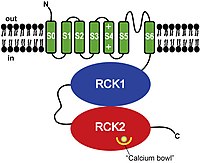
Photo from wikipedia
Upon membrane depolarization, the KCNQ1 potassium channel opens at the intermediate (IO) and activated (AO) states of the stepwise voltage-sensing domain (VSD) activation. In the heart, KCNQ1 associates with KCNE1… Click to show full abstract
Upon membrane depolarization, the KCNQ1 potassium channel opens at the intermediate (IO) and activated (AO) states of the stepwise voltage-sensing domain (VSD) activation. In the heart, KCNQ1 associates with KCNE1 subunits to form IKs channels that regulate heart rhythm. KCNE1 suppresses the IO state so that the IKs channel opens only to the AO state. Here, we tested modulations of human KCNQ1 channels by an activator ML277 in Xenopus oocytes. It exclusively changes the pore opening properties of the AO state without altering the IO state, but does not affect VSD activation. These observations support a distinctive mechanism responsible for the VSD-pore coupling at the AO state that is sensitive to ML277 modulation. ML277 provides insights and a tool to investigate the gating mechanism of KCNQ1 channels, and our study reveals a new strategy for treating long QT syndrome by specifically enhancing the AO state of native IKs currents.
Journal Title: eLife
Year Published: 2019
Link to full text (if available)
Share on Social Media: Sign Up to like & get
recommendations!